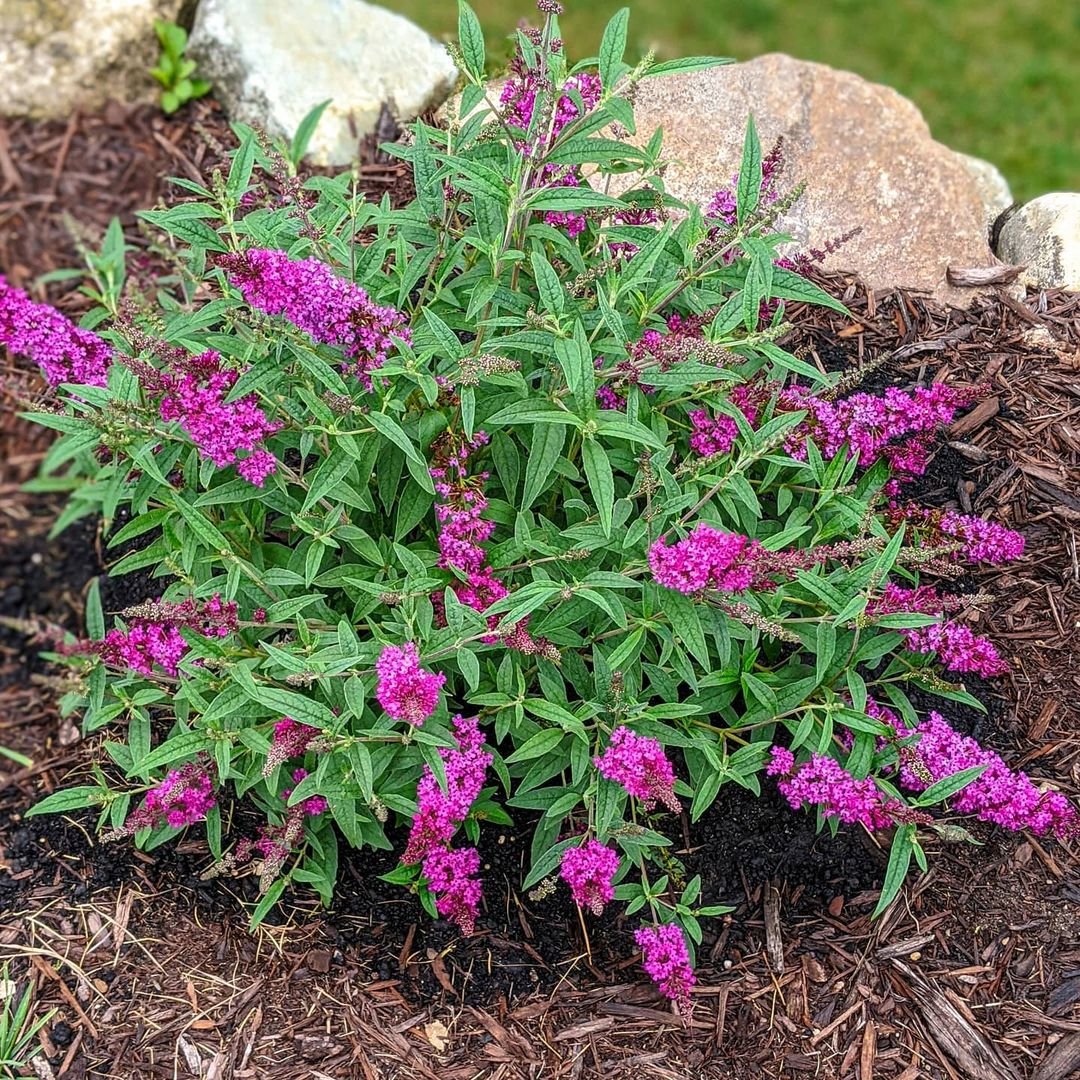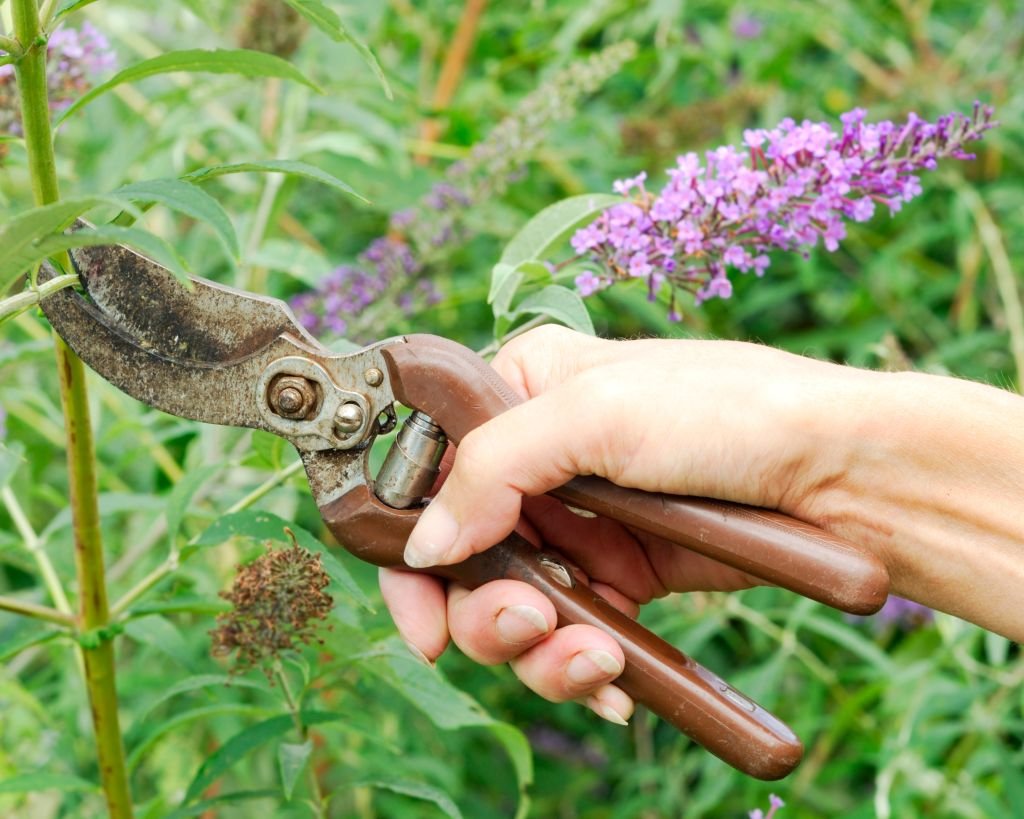Butterfly Bushes attract pollinators with their showy blooms, but some varieties are invasive. Learn how to grow non-invasive cultivars responsibly in your garden.
Butterfly Bushes a dazzling addition to any garden. With its vibrant blooms and sweet fragrance, this resilient shrub attracts butterflies and hummingbirds, bringing life and color to your outdoor space. Easy to grow and maintain, it’s the perfect choice for both novice and seasoned gardeners alike.
Here’s a concise information chart about Butterfly Bushes:
| Attribute | Information |
|---|---|
| Botanical Name | Buddleja davidii |
| Plant Type | Deciduous shrub |
| Zones | 5-9 (varies by cultivar) |
| Exposure | Full sun |
| Bloom Time | Summer to fall |
| Height/Spread | Height: 3-10 feet Spread: 3-12 feet |
How to Grow Butterfly Bushes Responsibly

With their cone-shaped clusters of vibrant purple, pink or white flowers, it’s no wonder butterfly bushes (Buddleja davidii) are a favorite of many gardeners. These deciduous shrubs are magnets for butterflies, hummingbirds and other pollinators during the summer months.
However, the Buddha bush isn’t without its controversies. While beloved for their effortless blooms and ability to thrive in tough conditions, butterfly bushes are infamous for their invasive tendencies in certain regions too.
That doesn’t mean you need to avoid these beautiful plants entirely! With the right non-invasive varieties and responsible growth habits, butterfly bushes can still be grown safely to provide nectar-rich blooms for your local pollinators.
What are Butterfly Bushes?

Butterfly bushes are multi-stemmed, deciduous shrubs that typically grow 5-10 feet tall, though dwarf varieties are available. Native to China, they produce showy, spike-like clusters of small, fragrant flowers in colors like purple, pink, white, red, yellow or bi-colors.
These aromatic blooms are extremely attractive to butterflies, hummingbirds, bees and other nectar-seeking pollinators throughout the summer months. The long, cone-shaped flower spikes can reach 6-20 inches and make eye-catching cut flowers too.
While beautiful, the species butterfly bush (Buddleja davidii) is listed as an invasive plant in many parts of the United States. This is due to its aggressive self-seeding and spread from garden plantings into wild areas where it can displace native species.
To avoid these issues, gardeners should focus on planting only approved, non-invasive cultivars with low fertility rates. These are safe to grow in most regions while still providing a valuable nectar source for local pollinators.
Benefits of Growing Butterfly Bushes

When grown responsibly with sterile varieties, butterfly bushes offer gardeners numerous advantages:
- Extremely easy to grow in most climates and soil conditions
- Don’t require staking, spraying or special care to bloom
- Drought-tolerant once established in the landscape
- Cold hardy down to Zone 5 in many regions
- Available in compact sizes for small spaces and planters
- Bloom continuously from summer until first frosts
- Act as magnets for butterflies, hummingbirds and beneficial pollinators
While the shrubs can reach mature sizes up to 10 feet tall, there is an abundance of dwarf cultivars like the Lo & Behold series that only grow 2-3 feet high. These are ideal for foundation plantings or even larger patio containers.
Combine their easy maintenance with incredibly long bloom periods, and it’s clear why butterfly bushes are such a beloved warm-weather plant! Just be sure to focus on approved, non-invasive selections.
Growing Non-Invasive Butterfly Bushes

Selecting the right low-fertility varieties from the start is key to growing butterfly bushes responsibility. Here are some tips:
Choosing Non-Invasive Cultivars
To avoid spreading into wild areas, choose named cultivars rather than planting the straight species butterfly bush (Buddleja davidii). Sterile, seedless varieties do not produce viable seed and are safe for most regions.
Some non-invasive varieties to consider include:
- ‘Blue Chip’ dwarf buddleia (Proven Winners)
- Lo & Behold® dwarf buddleia series (Multiple colors)
- ‘Miss Ruby’ dwarf butterfly bush
- ‘Miss Molly’ red-flowered variety
- ‘Summer Beauty’ compact butterfly bush
- Buzz™ Series like ‘Buddleia Buzz Hot Raspberry’
- ‘Crown Jewels’ and other overwintering Proven Winners cultivars
Always double check if a variety is approved for your local area. These are considered “pavement plants” that won’t escape into natural areas.
Site Selection and Planting

Plant butterfly bushes in full sun for maximum flowering potential. While tolerant of partial shade, plants grown in too much shade may not bloom as heavily.
Before planting, amend the soil by mixing in a 2-3 inch layer of compost or manure down to 12 inches deep over a wide area. This creates a richer growing medium for the shrubs.
Space your plants 4-6 feet apart, depending on their expected mature size. Dig a hole twice as wide as the rootball but no deeper. Set plants at the same depth as they were previously growing.
Fill in around the rootball with the amended soil and firm down lightly with your hands to remove any air pockets. Stake taller varieties if needed to prevent wind damage while roots get established.
Finish with a 2-3 inch layer of mulch to retain soil moisture and keep weed growth down around the base of plants.
Watering and Fertilization

Provide new butterfly bush plants with regular irrigation during their first year to develop a strong root system. Established shrubs, however, are quite drought tolerant once settled into the landscape.
An annual application of a balanced fertilizer or compost in early spring can help promote vigorous flowering. Avoid over-fertilizing though, which leads to tall, lanky growth. Let the soil dry out slightly between waterings once plants are established as butterfly bushes can tolerate some drought.
Pruning and Maintenance

In mild climates where plants stay evergreen, cut back butterfly bushes to about 12 inches annually in early spring to remove any damaged or errant growth.
For gardeners in cold climates where bushes die back over winter, wait until you see new growth emerging from the base before pruning out any dead wood. Remove damaged canes all the way to the plant’s base.
No hard pruning is needed to keep butterfly bushes flowering, though a light shearing back after the first summer bloom cycle can sometimes encourage more flushes of flowers to develop later in the season.
Simply remove spent flowerheads periodically to prevent any unwanted self-seeding. Cut off spent blooms down to the next flowering side shoot, careful not to remove too much foliage.
Responsibly Limit Spreading
Even with sterile cultivars, it’s smart to remove any seed heads or suckers popping up around desirable plants each season. This prevents the plant from potentially spreading beyond its intended planted area.
While non-invasive varieties are less vigorous, they still have the capability to colonize larger areas if allowed to spread unchecked. Responsible monitoring is needed to maximize containment.
Once you’ve pruned away any unwanted spreading stems or seedheads, discard or destroy this plant material rather than composting it.
With some basic care and diligence each year, you can easily grow these unique summer-blooming shrubs while avoiding any invasiveness issues. The butterflies, hummers and other pollinators will certainly appreciate the rich nectar sources too!
Incorporate a few butterfly bushes into your garden routine and you’ll be rewarded with brilliant, long-lasting bursts of color sure to attract winged visitors of all kinds. Just choose your plants wisely to maintain responsibility.
Tips for Attracting Pollinators

With their large, showy flower spikes and sweet nectar, butterfly bushes are incredibly valuable for luring all sorts of pollinators to your garden. To maximize their appeal, try implementing some of these tips:
Plant in Drifts – Mass multiple plants together in groupings for greater visual impact and easier access for pollinators like butterflies. The colors and aromas are more noticeable this way.
Use Different Varieties – Include an assortment of flower colors like purple, pink, white, yellow and bicolors. This diversity provides food sources for a wider range of pollinator species.
Include Water Sources – Set out shallow bird baths, water dishes or small ponds for pollinators to get hydration near the nectar-rich butterfly bushes.
Stagger Bloom Times – Grow both early and late-blooming buddleia cultivars to provide nectar for an extended season from spring through fall.
Enhance with Companions – Interplant complementary, pollinator-friendly perennials like coneflowers, bee balm, salvias and zinnias around your butterfly bush groupings.
Provide Shelter – Leave some areas unraked with leaf litter, brush piles or standing dead trees so pollinators have places to overwinter or nest.
Follow these tips and you’ll have fluttering visitors all season long! The Buddha bushes will certainly earn their reputation as magnets for butterflies and other valuable pollinators.
Butterfly Bush Alternatives
If you live in a region where butterfly bushes are still considered potentially invasive even with sterile cultivars, there are some excellent native plant alternatives to consider:
1. Buttonbush (Cephalanthus occidentalis) – A shrub for moist areas with spiky white ball-shaped flowers loved by bees and butterflies.
2. Chokecherry (Prunus virginiana) – Clusters of white spring blooms and summer berries adored by birds and pollinators on this large native shrub.
3. New Jersey Tea (Ceanothus americanus) – Low-growing groundcover with clouds of small, fuzzy white blooms and nice fall color.
4. Summersweet (Clethra alnifolia) – Extremely fragrant white or pink flower spikes cover this compact native shrub in mid-summer.
Any of these and other regional native shrubs will make wonderful magnets for butterflies, pollinators and wildlife without any invasive worries. Just be sure to plant species suited to your growing zone and conditions.
So don’t hesitate to add some butterfly bushes to your landscape, provided you stick to safe, non-invasive varieties! With their bright colors, sweet fragrance and season-long blooms, these beauties are sure to liven up any sunny garden.
Just stay responsible in your plantings and cultural care. With a little diligence, we gardeners can enjoy all the delightful pollinator activity these unique shrubs attract without threatening natural areas.
Pingback: - Growing Aloes: A Comprehensive Guide to Cultivating Aloe Plants
Pingback: Butterfly Bushes: Tips for Growing Beautiful Va...
Pingback: Black and Yellow Caterpillars (With Pictures) – Identification Guide
Pingback: Butterflies: The Ultimate Spotter’s Guide to Winged Wonders
Pingback: Ceanothus: Comprehensive Care and Maintenance Guide
Pingback: 15 Popular Types of Succulents for Your Garden - Gardener's School
Pingback: How to Grow Hollyhocks : A Step-by-Step Guide - Gardener's School
Pingback: Cranesbill (Hardy Geranium) Care : The Definitive Handbook - Gardener's School
Pingback: Blue Butterfly Bush : A Colorful Addition to Your Garden -